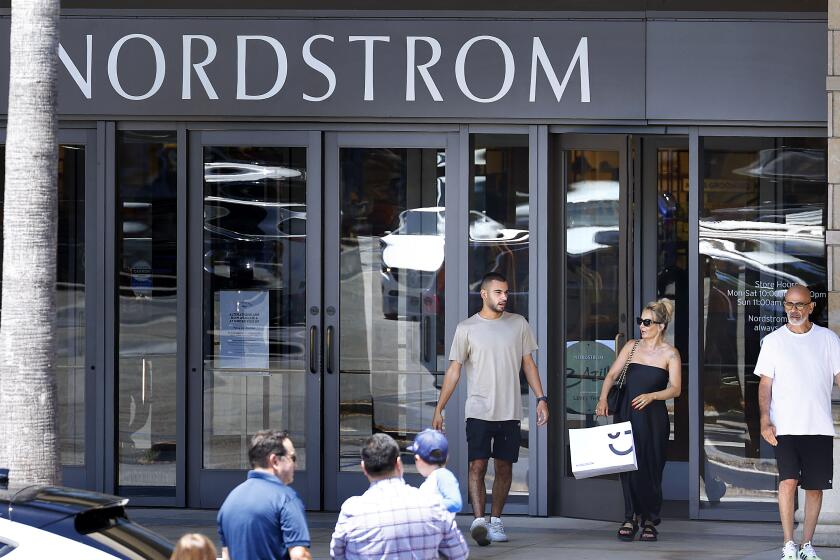Soft Growth in Jobs Makes Markets Jump : Economy: Investors see unexpected modest gain as sign that Fed won’t need to raise interest rates again soon. Stocks, bonds climb, with Dow rising 235 points.
- Share via
WASHINGTON — Jobs grew at an unexpectedly gentle rate during August while wages rose moderately, news that triggered sharp rallies Friday in stock and bond markets in the hope that a possible slowdown will hold inflation in check.
The Labor Department said the economy spun off only 124,000 new jobs in August, the smallest increase since May but still enough to push the unemployment rate down a notch to 4.2%. Non-farm workers’ hourly earnings rose only 0.2% to $13.30, up 2 cents from July.
Investors, apparently reading the news as a sign that the Federal Reserve would not have to raise interest rates again soon to control inflation, drove stock and bond prices sharply higher.
But some analysts say that judgment may be premature.
The U.S. unemployment rate was reported at 4.2%, in line with projections. The figure has wavered between 4.2% and 4.3% since March, this country’s lowest unemployment rate in 29 years.
Such low unemployment has, in the past, given rise to wage pressure and inflation, and the absence of this usual cause-and-effect relationship in the current economy has given rise to debate about what, if anything, the Fed should do.
Since February, the Fed has been on a hair-trigger alert for signs that inflation has begun to incubate. Twice this summer it raised interest rates in preemptive strikes that some economists called unnecessary.
Fed Chairman Alan Greenspan has said that, of all the indicators helping to shape his thinking on interest rates, he is watching labor-market statistics most intently. Friday’s figures are considered crucial because they were the last such figures to be published before the Fed’s policymaking committee next meets on Oct. 5.
So when the Labor Department announced that hourly wages remained in check, investors concluded that Fed policymakers would go into their meeting with no compelling reason to raise interest rates. A powerful rally on Wall Street began as soon as the markets opened Friday morning, pushing up the Dow Jones industrial average by 235 points, to 11,078.
“It just seems like they overreact to everything,” said David M. Jones, an economist at the bond firm of Aubrey G. Lanston. “As soon as there’s a little bit of grounds for optimism, the market just explodes.”
Jones, who calls himself more of a hawk on inflation than the overall market, said that, before Friday’s weak job report, various agencies had been releasing a string of lower-profile statistics that pointed to rising inflationary pressure.
He cited a recent record in new home sales, an upward revision in unit labor costs, unexpectedly slow productivity growth and a monthly survey of purchasing managers (covering inventories, commodity prices and factory orders, among other indicators) that suggested upward price pressure.
Even if the Fed leaves interest rates untouched in October, it could still raise them at its November meeting.
“The November meeting is more important than the October meeting,” said Mark Vitner, economist at First Union Corp. in Charlotte, N.C. By then, he said, the Fed will have had time to digest a wealth of data since its two rate hikes earlier this summer.
“They will have had enough time to see the impact of what they’ve done so far,” said Vitner, who thinks the data will convince the Fed it still hasn’t done enough to chill the economy.
Analysts were not terribly worried the economy produced barely half as many new jobs last month as a consensus of private economists had forecast. They pointed out that the job-creation figures for July had been higher than expected--as a result, financial markets trembled that day--and so the two months simply offset each other.
“I never take one month as a sign that a new trend is beginning,” said Jared Bernstein, economist at the Economic Policy Institute in Washington. When the July and August figures are averaged, he said, the result is in line with the first six months of the year.
Some analysts, delving behind the overall job-creation statistic, said it might shed light on the vexing question of why the U.S. economy seems able to sustain 4.2% or 4.3% unemployment month after month without generating inflation.
They said August’s reported loss of 29,000 construction jobs wasn’t ominous--construction statistics always jump around--but they were intrigued that manufacturing employment fell by 63,000. “You have to ask yourself why employment is down when we have strong manufacturing output,” Jones said.
Higher productivity could account for some of the discrepancy, Jones added. He also pointed out that manufacturers were using thousands more temporary workers to meet peak production quotas. Temps who fill manufacturing jobs are classified by statisticians as service employees, he said.
And since temps typically earn less than staff employees do, he said, their increasing numbers were acting as a brake on inflation, even in a tight labor market.
That trend may end soon, however. Unions, which don’t like the use of temps and sense that their members haven’t shared the fruits of the economic boom, may refocus on wage gains after a long emphasis on job security.
Machinists at Boeing Co. just won hefty raises for the next three years plus a 10% bonus at signing, and flight attendants at Northwest Airlines recently turned down a package of raises and pension increases as insufficient. The United Auto Workers of America is now in contract talks with all three major car manufacturers, and the International Assn. of Machinists and Aerospace Workers is negotiating with US Airways Group.
(BEGIN TEXT OF INFOBOX / INFOGRAPHIC)
The Job Market
The nation’s unemployment rate dropped slightly in August.
*
JOBLESS RATE: Aug. 4.2%
*
NEW JOBS: 124,000
Source: Labor Department
More to Read
Inside the business of entertainment
The Wide Shot brings you news, analysis and insights on everything from streaming wars to production — and what it all means for the future.
You may occasionally receive promotional content from the Los Angeles Times.










